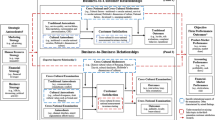Abstract
Quantitative analysis with respect drivers of customer satisfaction in a projectoriented, business-to-business environment is very scarce. The aim of this paper is to make headway into this terrain by statistical analysis of quantitative empirical research. Five drivers of satisfaction are posited. Analysis of 41 observations shows that the overall model is highly reliable, valid and generalizable. The overall model fit is excellent. Bi-variate correlation shows the promise of the individual drivers of satisfaction. However, multiple regression analysis suffers from a large degree of multicollinearity. Based on this regression, ‘Solution’ is the only driver of satisfaction that can unequivocally be accepted, being both significant and meeting effect size requirements. A larger dataset (N > 80) is recommended for further research to combat multicollinearity and test smaller effect sizes.
Access this chapter
Tax calculation will be finalised at checkout
Purchases are for personal use only
Preview
Unable to display preview. Download preview PDF.
Similar content being viewed by others
References
Beelaerts WWA, Verhagen WJC, Santema SC. The Effects of Co-Innovation on the Value-time Curve: Quantitative Study on Product Level, Journal of Business Market Management, 2008, 2:1, pp. 5-24.
Berry LL. Discovering the Soul of Service: the Nine Drivers of Sustainable Business Success, Palm Reader E-books, 1998.
Bingguang L, Riley MW, et al., A comparison study of customer satisfaction between the UPS and Fed-Ex: an empirical study among university customers, Industrial Management & Data Systems, 2006, 106: 2, pp. 182-199.
Bruhn M, Grund MA. Theory, development and implementation of national customer satisfaction indices: the Swiss Index of Customer Satisfaction (SWICS), Total Quality Management & Business Excellence, 2000, 11:7, pp. 1017-1028
Chakraborty G, Shrivastava P, Marshall F. Are drivers of customer satisfaction different from buyers/users from different functional areas?, Journal of Business and Industrial Marketing, 2000, 22:1, pp. 20-28.
Cronin JJ jr., Taylor SA. Measuring Service Quality: A re-examination and Extension, Journal of Marketing, 1992, 56:3, pp. 55-68.
Eskildsen J, Kristensen K, Juhl HJ and Østergaard P. The Drivers of Customer Satisfaction and Loyalty. The Case of Denmark 2000-2002, Total Quality Management & Business Excellence, 2004, 15:5, pp. 859 -868
Fornell C. A national customer satisfaction barometer: the Swedish experience, Journal of Marketing, 1992, 56:1, pp. 6-21.
Field A. Discovering Statistics using SPSS, 3rd ed., London: Sage Publications, Inc., 2005.
Fink A. Conducting Research Literature Reviews, 1st ed., London: Sage Publications, Inc., 1998.
Gonzalez H, Fredericks J. Guidelines to Co-operation, Quirks Marketing Research Review, 2007, 21:3.
Hair JF, Anderson RE, Tatham RL, William C. Multivariate Data Analysis, 5th Ed., Upper Saddle River: Prentice-Hall, 1998.
Hakonsson H. Industrial Marketing and Purchasing of Industrial Goods – An Interaction Approach, John Wiley & Sons, London, 1982.
Heskett JL, Sasser WE, Schlesinger LA. The Service Profit Chain: How Leading Companies Link Profit and Growth to Loyalty, Satisfaction, and Value, Free Press, 1997.
Hill N. Customer satisfaction measurement for ISO 9000, 1st ed., Elsevier Science & Technology, 2001.
Homburg C, Rudolph B. Customer satisfaction in industrial markets: dimensional and multiple role issues, Journal of Business Research, 2001, 52:1, pp. 15-33.
Kotler P, Keller K. Marketing Management, 13th ed., Upper Saddle River: Prentice-Hall, 2008.
Oshagbemi T. Overall job satisfaction: how good are single versus multiple-item measures?, Journal of Managerial Psychology, 1999, 14:5, pp. 388–403.
Porter, ME. Competitive advantage: creating and sustaining superior performance, London: Simon & Schuster Ltd., 1998.
Reichheld FF. The Loyalty Effect: The Hidden Force Behind Growth, Profits, and Lasting Value, Boston: Harvard Business Press, 1996.
Rossomme J. Customer satisfaction measurement in a business-to-business context: a conceptual framework, Journal of Business and Industrial Marketing, 2003: 18:2, pp. 179-95.
Sharma S, Niedrich RW, Dobbins G. A framework for monitoring customer satisfaction: an empirical illustration, Industrial Marketing Management, 1999, 28:1, pp. 231-43.
Author information
Authors and Affiliations
Corresponding author
Editor information
Editors and Affiliations
Rights and permissions
Copyright information
© 2009 Springer London
About this paper
Cite this paper
Verhagen, W., Beelaerts van Blokland, W., Curran, R. (2009). Drivers of Customer Satisfaction in a Project-Oriented, Business-to-Business Market Environment: An Empirical Study. In: Chou, SY., Trappey, A., Pokojski, J., Smith, S. (eds) Global Perspective for Competitive Enterprise, Economy and Ecology. Advanced Concurrent Engineering. Springer, London. https://doi.org/10.1007/978-1-84882-762-2_79
Download citation
DOI: https://doi.org/10.1007/978-1-84882-762-2_79
Publisher Name: Springer, London
Print ISBN: 978-1-84882-761-5
Online ISBN: 978-1-84882-762-2
eBook Packages: EngineeringEngineering (R0)




